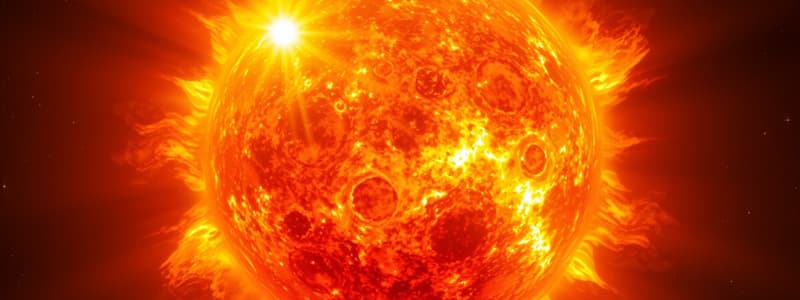Podcast
Questions and Answers
In the standard solar model, as the distance from the center increases, what happens to the density?
In the standard solar model, as the distance from the center increases, what happens to the density?
- The density decreases faster than the temperature (correct)
- The density remains constant
- The density and temperature are unrelated
- The density increases faster than the temperature
Solar energy is produced by what process?
Solar energy is produced by what process?
- Chemical reactions in the core
- Combustion of hydrogen
- Fission of heavy nuclei
- Fusion of light nuclei to make heavier ones (correct)
The most abundant element in the Sun is hydrogen.
The most abundant element in the Sun is hydrogen.
True (A)
Sunspots appear dark because they are hotter than the surrounding gas of the photosphere.
Sunspots appear dark because they are hotter than the surrounding gas of the photosphere.
A typical solar granule is about the size of what?
A typical solar granule is about the size of what?
The time between successive sunspot maxima is approximately how long?
The time between successive sunspot maxima is approximately how long?
Why does the surface of the Sun appear to have a sharp edge?
Why does the surface of the Sun appear to have a sharp edge?
What layer of the Sun are we referring to when discussing temperature, luminosity, and chemical composition?
What layer of the Sun are we referring to when discussing temperature, luminosity, and chemical composition?
What is the surface temperature of the Sun?
What is the surface temperature of the Sun?
What is the underlying cause of the flow pattern known as supergranulation on the Sun's surface?
What is the underlying cause of the flow pattern known as supergranulation on the Sun's surface?
Granulation is evidence of what phenomenon?
Granulation is evidence of what phenomenon?
What two forces are in balance inside the Sun?
What two forces are in balance inside the Sun?
Which of the following processes of energy transport are NOT important inside the Sun?
Which of the following processes of energy transport are NOT important inside the Sun?
Why do sunspots appear dark?
Why do sunspots appear dark?
Which of the following statements about sunspots is NOT true?
Which of the following statements about sunspots is NOT true?
What is the common cause of sunspots, flares, and prominences?
What is the common cause of sunspots, flares, and prominences?
The helium produced from the fusion of hydrogen has less mass than the hydrogen that goes into its formation. What happens to the missing matter?
The helium produced from the fusion of hydrogen has less mass than the hydrogen that goes into its formation. What happens to the missing matter?
What is the primary source of energy for the Sun?
What is the primary source of energy for the Sun?
The Sun has sufficient hydrogen to continue fusing into helium for how much longer?
The Sun has sufficient hydrogen to continue fusing into helium for how much longer?
Flashcards are hidden until you start studying
Study Notes
Solar Model and Structure
- In the standard solar model, density decreases faster than temperature as one moves away from the Sun's center.
- The Sun's surface temperature is approximately 5780 K.
Solar Energy Production
- Solar energy is produced through the fusion of light nuclei into heavier ones.
- The primary energy source of the Sun is the fusion of hydrogen into helium.
Elements in the Sun
- Hydrogen is the most abundant element in the Sun, confirming its pivotal role in solar fusion processes.
Characteristics of Sunspots
- Sunspots appear dark because they are cooler than the surrounding hotter gas of the photosphere.
- Sunspots are not uniformly distributed; they tend to cluster near the equator and vary in number based on an approximately 11-year cycle.
- The time between successive sunspot maxima is about a decade.
Layers and Phenomena
- The photosphere is a thin layer compared to other atmospheric regions, leading the Sun to appear with a sharp edge.
- The photosphere is crucial for discussing the Sun's temperature, luminosity, and chemical composition, as it allows light to escape.
- Granulation in the photosphere indicates convection occurring just below its surface, while supergranulation results from deeper convective flows.
Forces and Energy Transport
- Inside the Sun, forces are balanced between gravity pulling inward and gas pressure pushing outward.
- Energy transport mechanisms in the Sun prioritize radiation and convection, with conduction being relatively unimportant.
Solar Phenomena and Magnetic Fields
- Common causes of sunspots, flares, and prominences include magnetic fields, which play a significant role in these solar activities.
Matter and Energy Conversion
- Helium produced from hydrogen fusion has less mass than the original hydrogen, with the missing mass being converted into energy, which accounts for the Sun's energy output.
- The Sun has enough hydrogen to continue fusion for approximately 5 billion more years.
Studying That Suits You
Use AI to generate personalized quizzes and flashcards to suit your learning preferences.




